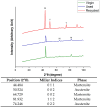Evaluation of Recycled and Reused Metal Powders for DMLS 3D Printing
- PMID: 39769784
- PMCID: PMC11678191
- DOI: 10.3390/ma17246184
Evaluation of Recycled and Reused Metal Powders for DMLS 3D Printing
Abstract
Metal powders for additive manufacturing are expensive, and producing new ones from mined metals has a negative ecological impact. In this work, recycled and reused metal powders from MS1 steel for direct metal laser sintering (DMLS) 3D printing were evaluated in the laboratory. The powders were recycled by melting followed by gas atomizing. Virgin, recycled, and reused metal powders were evaluated using scanning electron microscopy (SEM), energy-dispersive X-ray spectroscopy (EDS), X-ray diffraction (XRD), metallography analysis, microhardness measurements, particle size distribution (PSD), shape factor by digital image processing (DIP), and flowability testing. The results showed that the particle distribution was modified after recycling. Kurtosis analysis revealed a reduction from -0.64 for virgin powders to -1.29 for recycled powders. The results demonstrated a positive skewness, indicating that the recycled powder contained a greater proportion of smaller particles. The shape factor was also modified and changed from 1.57 for virgin powders to 1.28 for recycled powders. The microstructure also changed, and austenite was found in the recycled powders. The microhardness of recycled powder decreased by 39% compared to the virgin powder. Recycled powders did not flow, using two different funnels to evaluate their flowability. The flowability of used powder was reduced from 4.3 s to 2.9 s.
Keywords: 3D printing; DMLS; MS1; additive manufacturing; metal powders; recycling.
Conflict of interest statement
The authors declare no conflict of interest.
Figures








References
-
- Cooke S., Ahmadi K., Willerth S., Herring R. Metal additive manufacturing: Technology, metallurgy and modelling. J. Manuf. Process. 2020;57:978–1003. doi: 10.1016/j.jmapro.2020.07.025. - DOI
-
- Peng T., Kellens K., Tang R., Chen C., Chen G. Sustainability of additive manufacturing: An overview on its energy demand and environmental impact. Addit. Manuf. 2018;21:694–704. doi: 10.1016/j.addma.2018.04.022. - DOI
-
- Citarella R., Giannella V. Additive Manufacturing in Industry. Appl. Sci. 2021;11:840. doi: 10.3390/app11020840. - DOI
-
- Admin . Sustainable Practices and Waste Recycling in Metal Additive Manufacturing. Inside Metal Additive Manufacturing; Andover, UK: 2024. [(accessed on 11 November 2024)]. Available online: https://insidemetaladditivemanufacturing.com/2024/06/10/sustainable-prac...
Grants and funding
LinkOut - more resources
Full Text Sources

